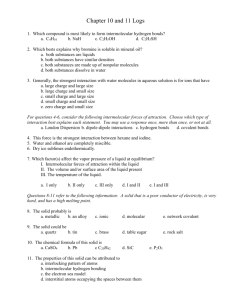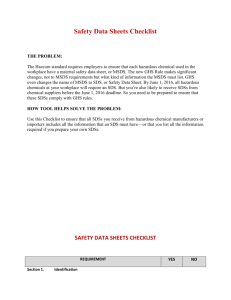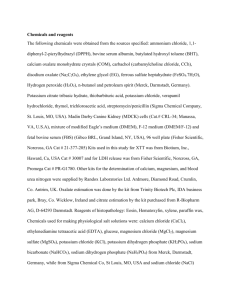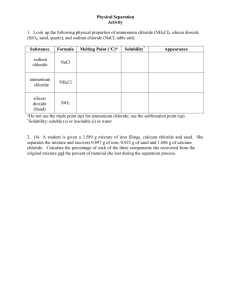MSDS - Zodiac
advertisement
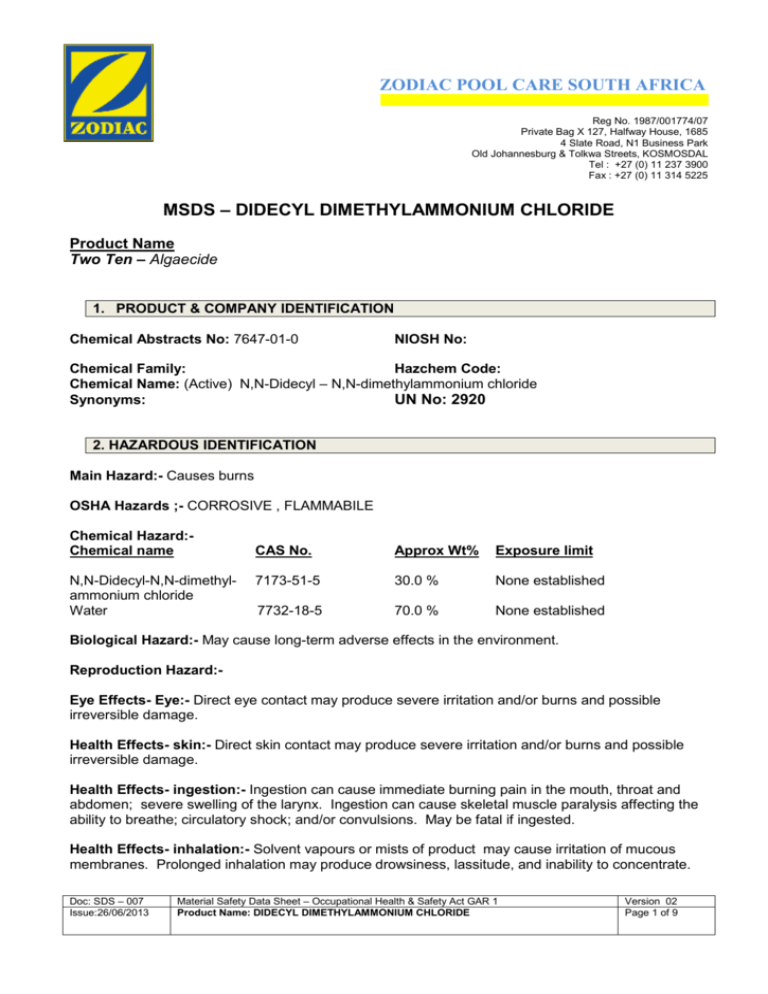
` ZODIAC POOL CARE SOUTH AFRICA Reg No. 1987/001774/07 Private Bag X 127, Halfway House, 1685 4 Slate Road, N1 Business Park Old Johannesburg & Tolkwa Streets, KOSMOSDAL Tel : +27 (0) 11 237 3900 Fax : +27 (0) 11 314 5225 MSDS – DIDECYL DIMETHYLAMMONIUM CHLORIDE Product Name Two Ten – Algaecide 1. PRODUCT & COMPANY IDENTIFICATION Chemical Abstracts No: 7647-01-0 NIOSH No: Chemical Family: Hazchem Code: Chemical Name: (Active) N,N-Didecyl – N,N-dimethylammonium chloride Synonyms: UN No: 2920 2. HAZARDOUS IDENTIFICATION Main Hazard:- Causes burns OSHA Hazards ;- CORROSIVE , FLAMMABILE Chemical Hazard:Chemical name N,N-Didecyl-N,N-dimethylammonium chloride Water CAS No. Approx Wt% Exposure limit 7173-51-5 30.0 % None established 7732-18-5 70.0 % None established Biological Hazard:- May cause long-term adverse effects in the environment. Reproduction Hazard:Eye Effects- Eye:- Direct eye contact may produce severe irritation and/or burns and possible irreversible damage. Health Effects- skin:- Direct skin contact may produce severe irritation and/or burns and possible irreversible damage. Health Effects- ingestion:- Ingestion can cause immediate burning pain in the mouth, throat and abdomen; severe swelling of the larynx. Ingestion can cause skeletal muscle paralysis affecting the ability to breathe; circulatory shock; and/or convulsions. May be fatal if ingested. Health Effects- inhalation:- Solvent vapours or mists of product may cause irritation of mucous membranes. Prolonged inhalation may produce drowsiness, lassitude, and inability to concentrate. Doc: SDS – 007 Issue:26/06/2013 Material Safety Data Sheet – Occupational Health & Safety Act GAR 1 Product Name: DIDECYL DIMETHYLAMMONIUM CHLORIDE Version 02 Page 1 of 9 Carcinogenicity:- Material listed as carcinogen Mutagenicity:Neurotoxicity:Effects of overexposure : Based on animal test data for this material, the following effect(s) can be anticipated : 3. COMPOSITION Component Didecyldimethylammonium chloride Ethanol Water CAS-No. 7173-51-5 64-17-5 7732-18-5 Weight percent 80,00 10,00 10,00 4. FIRST AID MEASURES Eye contact : For eye contact, immediately flush eyes with running water for at least 15 minutes. Hold eyelids apart to ensure rinsing of the entire surface of the eyes and lids with water. If physician is not available, flush for an additional 15 minutes. Get immediate medical attention. Skin contact : For skin contact, wash with plenty of running water, and soap if available, for 15 minutes. Remove and clean contaminated clothing and shoes. Get immediate medical attention. Wash clothing and decontaminate shoes before reuse. Ingestion : Get immediate medical attention. If swallowed, give 3-4 glasses of milk (if unavailable, water). DO NOT induce vomiting. If vomiting does occur, give fluids again. Get medical attention to determine if vomiting or evacuation of stomach is necessary. Do not give anything by mouth to an unconscious or convulsing person. Inhalation : If inhaled, remove from area to fresh air. Get immediate medical attention. If not breathing, clear airway and start artificial respiration. If victim is having trouble breathing, give supplemental oxygen, if available. Medical treatment : Probable mucosal damage may contraindicate the use of gastric lavage. Measures against circulatory shock, oxygen, and measures to support breathing manually or mechanically may be needed. If persistent, convulsions may be controlled by the cautious intraveneous injection of a short acting barbiturate drug. 5. FIRE AND EXPLOSION INFORMATION Extinguishing media to be used : Flash point : Protective Clothing : Doc: SDS – 007 Issue:26/06/2013 Carbon dioxide Dry chemical Alcohol foam Water 107 F Setaflash Closed Tester Material Safety Data Sheet – Occupational Health & Safety Act GAR 1 Product Name: DIDECYL DIMETHYLAMMONIUM CHLORIDE Version 02 Page 2 of 9 Must wear NIOSH / MSHA approved self-contained breathing apparatus and protective clothing. Cool fire-exposed containers with water spray. Unusual fire and explosion hazards : Products of combustion are toxic. Heated solvent vapours can travel to an ignition source and flash back. 6. ACCIDENTAL RELEASE MEASURES Personal Precautions:Use respirator when performing operations involving potential exposure to vapour of the product. Environmental Precautions:Do not flush into surface water or sanitary system Meathods for Containment Dike and control spill with inert material (sand, earth, etc.). Transfer the solid and liquid to separate containers for recovery or disposal. 7. HANDLING AND STORAGE Handling Avoid contact with skin and eyes. Provide sufficient air exchange and/or exhaust in work rooms. Advice on protection against fire and explosion: Highly flammable. Keep away from sources of ignition - No smoking. Take precautionary measures against static discharges. Storage Requirements for storage areas and containers : Keep container tightly closed.To maintain product quality, do not store in heat or direct sunlight. Keep in a dry, cool and well-ventilated place. Further information on storage conditions : Store containers in compliance with the most recent NFPA Code (NFPA 30). Ground all containers prior to pouring. Advice on common storage : Keep away from food, drink and animal feedingstuffs. Storage temperature : < 140 °F (< 60 °C) Precautions for storage and handling : Maximum storage temperature : 140 F. Store containers in compliance with the most recent NFPA Code (NFPA 30). Ground all containers prior to pouring. Keep containers closed until used. Do not contaminate drinking water, food or feed by storage or disposal. 8. EXPOSURE CONTROLS / PERSONAL PROTECTION Occupational Exposure Limits:Engineering control measures:Personal protection- Respiratory In processes where mists or vapours are generated, a NIOSH / MSHA approved respirator is advised in the absence of proper environmental controls or if TWA / TLV is exceeded. Personal protection-skin /hand: Use rubber or neoprene gloves, when needed, to prevent skin contact. Personal Protection- Eye Wear chemical splash goggles where there is a potential for eye contact. Use safety glasses with side shields under normal use conditions. Doc: SDS – 007 Issue:26/06/2013 Material Safety Data Sheet – Occupational Health & Safety Act GAR 1 Product Name: DIDECYL DIMETHYLAMMONIUM CHLORIDE Version 02 Page 3 of 9 Other protection- Ventilation : If mists or vapours may be generated, proper ventilation must be provided in accordance with good ventilation practices. 9. PHYSICAL AND CHEMICAL PROPERTIES Appearance: Liquid- Colourless to pale yellow Odour: Ethanol-like pH: 6.5 – 9 at 10% Boiling point: Not known Melting point: 10 C Flash point: Flammability: Auto flammability: Max. percent volatile : Explosive properties: Oxidizing properties: Vapour pressure: Not known 20% Density: 0.89 g / cm3 at 25 C Solubility - water: Soluble Solubility - solvent: Solubility - coefficient: Neurotoxicity: Evaporation rate (Butyl acetates = 1) : Not known Viscosity < 100 cps at 25 C 10. STABILITY AND REACTIVITY Stability : Stable Incompatibility with : Strong oxidising agents Conditions to avoid : None known 11. TOXICOLOGY INFORMATION Acute oral toxicity (LD50) : rat ; 450 mg / kg (80% active) Acute oral toxicity (LD50) : rat (male) : 412 mg / kg (50% active) Acute oral toxicity (LD50) : rat (female ; 292 mg / kg Acute dermal toxicity (LD50) : rabbit ; 3342 mg / kg 4300 mg / kg (two tests) (80% active) Doc: SDS – 007 Issue:26/06/2013 Material Safety Data Sheet – Occupational Health & Safety Act GAR 1 Product Name: DIDECYL DIMETHYLAMMONIUM CHLORIDE Version 02 Page 4 of 9 Skin irritation : rabbit : severe irritant extreme irritation that did not clear by day 7, post dose (primary irritation index = 110). Chronic toxicity : Oral dog : Test period : 1 year For Didecyldimethylammonium chloride : no target organ effects. LC 50 oral : Bobwhite quail : < 5620 ppm (and mallard duck) ; oral dietary Pharmacokinetic :dog : For Didecyldimethylammonium chloride : this material does not accumulate in body tissues. Sensitisation : guinea pig ; not sensitising For a 0.2% active solution. Mutagenicity : Salmonella : not mutagenic with or without metabolic activation (50% active). not mutagenic For Didecyldimethylammonium chloride : (Ames, CHO / HGPRT, CHO, DNA Syntheses). rat : No evidence of chromosomal damage in the bone marrow of rats treated with 600 mg / kg 950% active). Reproductive toxicity : rat : not teratogenic Treatment with 10 to 50 mg / kg on days 6 to 15 gestation (50% active) not teratogenic For Didecyldimethylammonium chloride : (rat and rabbit) treatment at or below mild toxic effect levels. rat : For Didecyldimethylammonium chloride : no reproductive effect for treatment at or below mild toxic effects level. Not clastogenic in Chinese hamster ovary cells with or without metabolic activiation (50% active). Subchronic toxicity : Dermal rat : Test period : 90 days For Didecyldimethylammonium chloride : no systemic toxicity : 12. ECOLOGICAL INFORMATION Fish toxicity (LC50) : bluegill sunfish : Test period ; 96 hours For Didecyldimethylammonium chloride : 0.32 mg / 1 Fish toxicity (LC50) : Test period : 96 hours For Didecyldimethylammonium chloride : (salmon) 1.0 mg / 1 Toxicity for Daphnia (EC50) daphnia magna : Doc: SDS – 007 Issue:26/06/2013 Material Safety Data Sheet – Occupational Health & Safety Act GAR 1 Product Name: DIDECYL DIMETHYLAMMONIUM CHLORIDE Version 02 Page 5 of 9 Test period : 48 hours For Didecyldimethylammonium chloride : 0.94 mg / 1 Dietary Toxicity Test : LC 50 oral : > 5620 ppm For Didecyldimethylammonium chloride : (bobwhite quail and mallard duck). Acute toxicity : LD 50 oral : Bobwhite quail : 229 mg / kg For Didecyldimethylammonium chloride : 13. DISPOSAL CONSIDERATIONS Disposal Methods Product : Dispose of in compliance with all Federal, state and local laws and regulations. Incineration is the preferred method. Disposal Methonds Packaging : CONTAINER DISPOSAL ; Triple rinse (or equivalent). Then offer for recycling or reconditioning, or puncture and dispose of in a sanitary landfill, or incineration, or, if allowed by state and local authorities, by burning. If burned, stay out of smoke. 14. TRANSPORTATION UN No. Substance Identity No. ADR/RID Class ADR/RID Item No. ADR/RID Hazard Identity No. IMDG- Shipping Name IMDG – Class IMDG – Packaging Group IMDG – Marine Pollutant IMDG – EMS No. IMDG – MFAG Table No. IATA – Shipping Name IATA – Class IATA – Subsidiary Risk(s) ADNR – Class UK – Description UK – Emergency Action Class UK – Classification Tremcard No. UN 2920 8 Not available 83 Corrosive Liquid, Flammable N.O.S. 8 II Yes F-E Corrosive Liquid, Flammable N.O.S. 8 CORROSIVE No.8 Not available Not available Not available Not available 15. REGULATORY INFORMATION EEC hazard classification: Risk phases: Safety phases: National legislation: FEDERAL LEVEL REGULATIONS Doc: SDS – 007 Issue:26/06/2013 Material Safety Data Sheet – Occupational Health & Safety Act GAR 1 Product Name: DIDECYL DIMETHYLAMMONIUM CHLORIDE Version 02 Page 6 of 9 Toxic Substances Control Act (TSCA) Inventory This product is currently listed on the EPA TSCA 8 (b) inventory list. US EPA Regulation on Pesticides ; This product is not an EPA registered pesticide. It cannot be used in the United States as a commercial antimicrobial agents without first obtaining an EPA FIFRA registration. It can be used commercially in non-antimicrobial applications, and for all research and development (R&D) applications including as a potential antimicrobial agent. CERCLA (Comprehensive Environmental Response, Compensation, and Liability Act of 1980). Requires notification of the National Response Centre (1-800-424-8802) of release of quantities of Hazardous Substances equal to or greater than the Reportable Quantities (RQs) in 40 CFR 302.4. The following components could require reporting : ***None*** SARA Title III ; Sections 302 / 304 (Superfund Amendments and Reauthorisation Act of 1986). Requires emergency planning based on Threshold Planning Quantities (TPQs) and release reporting based on Reportable Quantities (RQs) in 40 CFR 355. Components present in this product at a level which could require reporting under that statute are : ***None*** SARA Title III : Sections 311 / 312 (Superfund Amendments and Reauthorisation Act of 1986). Requires reporting under the Community Right-to-know provisions due t their inclusion in one of the five hazard categories listed in 40 CFR 370. Components present in this product which could require reporting under the statute are : IMMEDIATE (ACUTE) HEALTH HAZARD : Chemical Name CAS No N,N-Didecyl-N,N-Dimethylammonium 7173-51-5 Chloride DELAYED (CHRONIC) HEALTH HAZARD : ***None*** FIRE HAZARD Chemical Name CAS No Ethyl alcohol 64-17-5 REACTIVITY HAZARD : ***None*** Concentration (max/typ) 80% Concentration (max/typ) 10% SARA Title III : Section 313 (Superfund Amendments and Reauthorisation Act of 1986). Requires submission of annual reports of release of toxic chemicals that appear in 40 CFR 372. This information must be included in all MSDSs that are copied and distributed for this material. Components present in this product at a level which could require reporting under the statute are : ***None*** TSCA Section 12 (b) Export Notification Components present in this product which, if exported, could require either annual or one-time reporting under this regulation are as follows : ***None*** STATE RIGHT-TO-KNOW REGULATIONS : CALIFORNIA Proposition 65 Doc: SDS – 007 Issue:26/06/2013 Material Safety Data Sheet – Occupational Health & Safety Act GAR 1 Product Name: DIDECYL DIMETHYLAMMONIUM CHLORIDE Version 02 Page 7 of 9 Substance, which are known to the State of California to cause cancer and/or birth defects or other reproductive harm, must be identified when present in products. Components present in this product at a level which could require reporting under the statute in either or both hazard categories are : AS A CANCER HAZARD : Chemical name Acetaldehyde N-Nitrosodimethylamine CAS No. 75-07-0 62-75-9 Concentration (max/typ) 1 ppm 100 ppb MASSACHUSETTS RIGHT-TO-KNOW Substance List (MSL) Hazardous and Extraordinarily Hazardous Substances on the MSL must be identified when present in products. Components present in this product at a level which could require reporting under the statute are : EXTRAORD. HAZARDOUS SUBSTANCES (< = 1 ppm or 0.0001%) : Chemical name Acetaldehyde HAZARDOUS SUBSTANCES (< = 1.0%) : CAS No. 75-07-0 Concentration (max/typ) 1 ppm Chemical name CAS No. Concentration (max/typ) Ethyl alcohol 64-17-5 10% MICHIGAN CRITICAL MATERIALS This product contains the following substances identified on the Michigan Critical Materials Register : ***None*** NEW JERSEY RIGHT-TO-KNOW Substance List Requires Hazardous Substances and Specially Hazardous Substances on the list to be identified when present in products. Components present in this product at a level which could require reporting under the statute are : HAZARDOUS SUBSTANCES (< = 1.0 %) : Chemical name CAS No. N,N-Didecyl-N,N-dimethyl7173-51-5 lammonium chloride Ethyl alcohol 64-17-5 Concentration (max/typ) 80% 10% PENNSYLVANIA RIGHT-TO-KNOW Hazardous Substance List Hazardous Substances and Special Hazardous Substances on the List must be identified when present in products. Components present in this product at a level which could require reporting under the statute are : HAZARDOUS SUBSTANCES (<= 1.0%) : Chemical name CAS No. Concentration (max/typ) Ethyl alcohol 64-17-5 10% 16. FURTHER INFORMATION DISCLAIMER Zodiac Pool Care SA (Pty) Limited believes that this information is correct at date of publication but does not warrant the accuracy thereof. The use of the product designated herein will be at the sole risk of the user and Zodiac Pool Care SA (Pty) Limited will not accept any liability for any loss or damage, including consequential loss, howsoever caused by or arising from the use of this information of the use, application, adaption or Doc: SDS – 007 Issue:26/06/2013 Material Safety Data Sheet – Occupational Health & Safety Act GAR 1 Product Name: DIDECYL DIMETHYLAMMONIUM CHLORIDE Version 02 Page 8 of 9 processing of the product described herein or its use in combination with any other product, material or in any process. Date of General Update- 20 June 2014 Doc: SDS – 007 Issue:26/06/2013 Material Safety Data Sheet – Occupational Health & Safety Act GAR 1 Product Name: DIDECYL DIMETHYLAMMONIUM CHLORIDE Version 02 Page 9 of 9




